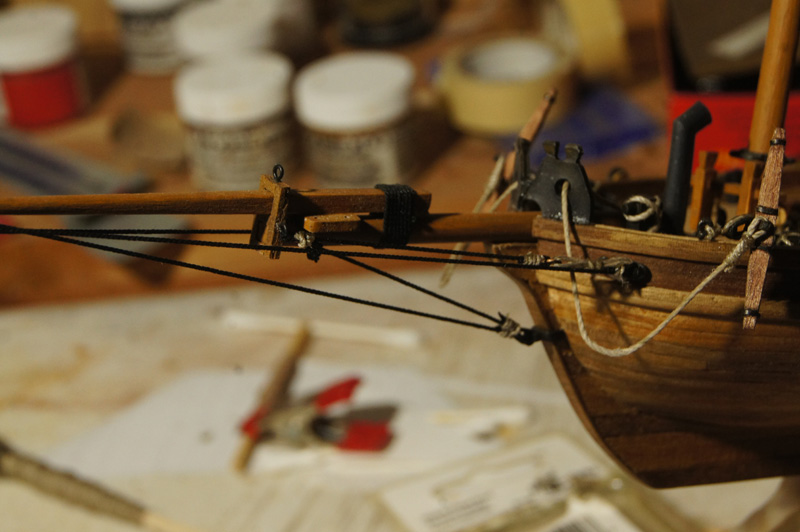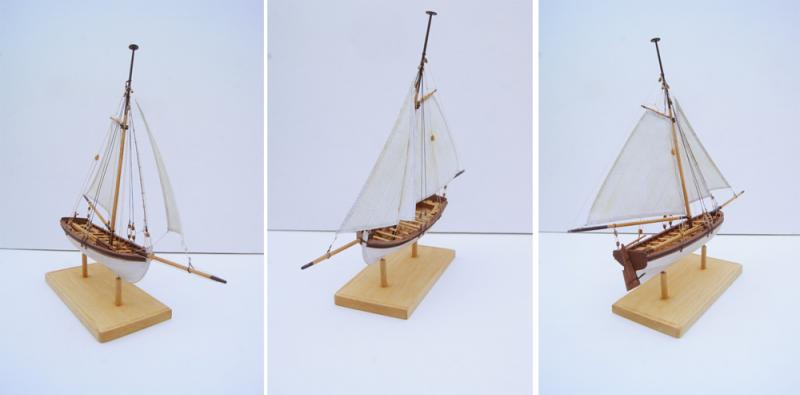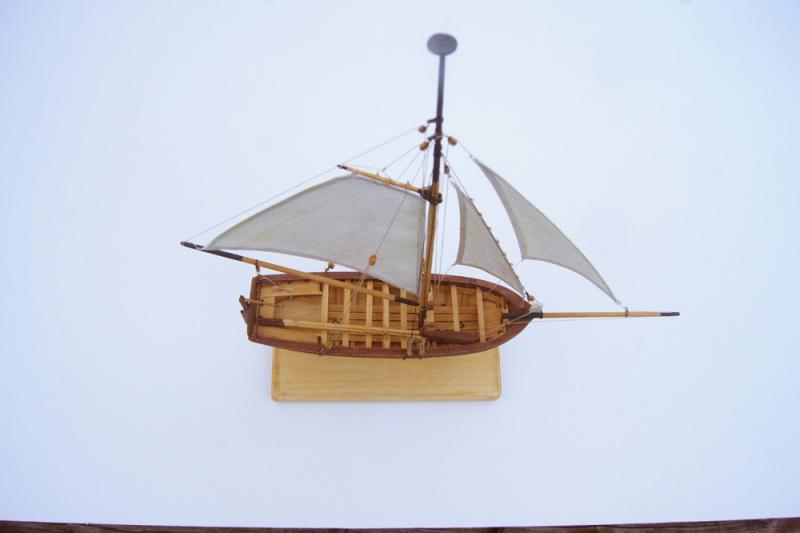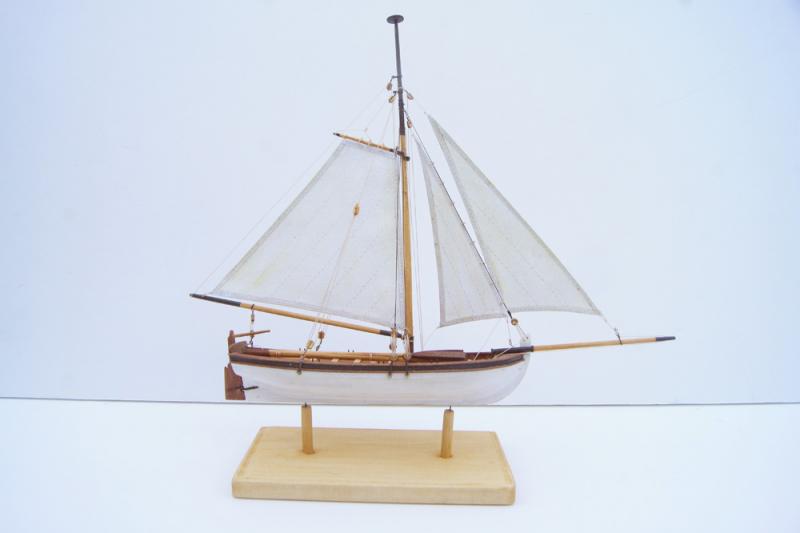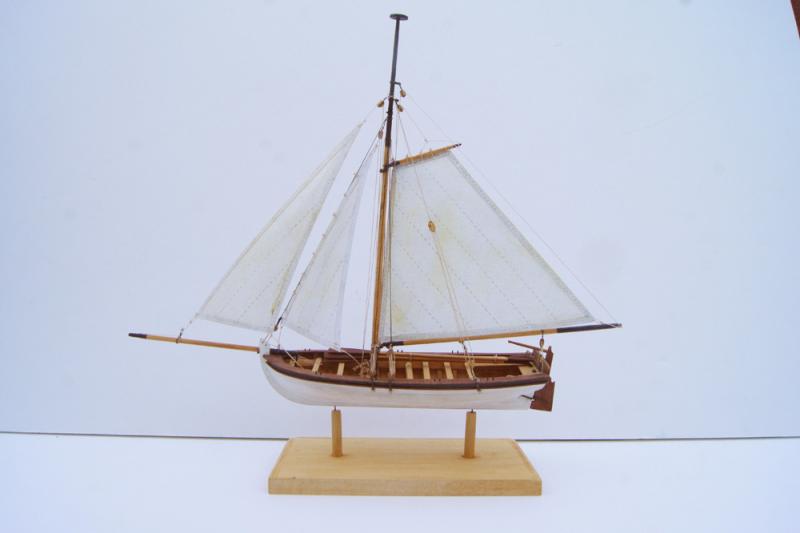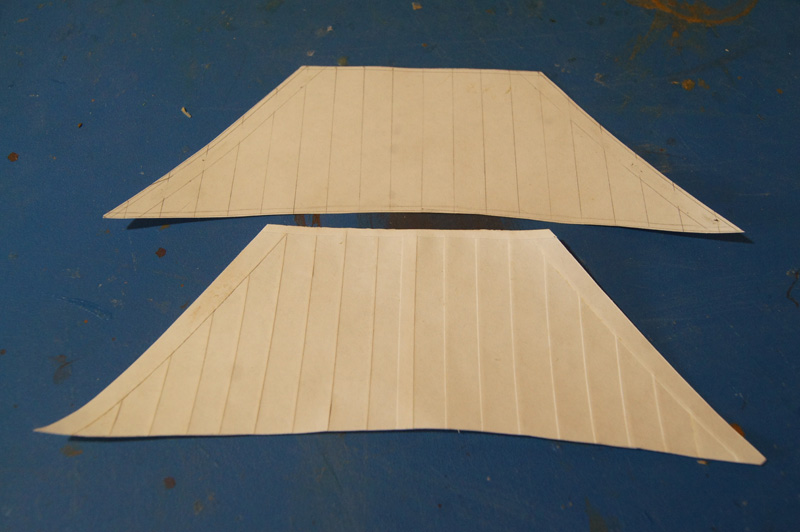-
Posts
3,538 -
Joined
-
Last visited
Content Type
Profiles
Forums
Gallery
Events
Everything posted by Cathead
-
I've spent much of the last week experimenting with sail design, finishing a topsail last night that I'm pretty happy with: I posted details about the design approach to this sail over on this thread on realistic sail-making, so won't duplicate that content here. Quick version, the out-of-scale boltropes are intentional, choosing function and an artistic look over strict accuracy. The sail is made of bond paper, with individual panels following real sail-making practice. What do you all think? I've also slowly moved forward on rigging. I started with the bowsprit assembly, since it's an isolated area that I can complete while getting my head around certain skills and methods. Now I need to move forward on the regular rigging, and have been studying the plans and other references obsessively to try and assemble a sensible plan that will minimize the need to reach around rigging to do other rigging. Certainly one first step is to make the rest of the sails and bend them to their respective booms/yards. I find rigging both fascinating and infuriating, so this should be an interesting time coming up. Of course, I have lots of time this weekend as we're under threat of an ice storm here in Missouri, so I won't be distracted by outdoor activities. On the other hand, if the power goes out, I may be working on this by candlelight just like the old-timers. What could go wrong?
- 96 replies
-
- topsail schooner
- revenue cutter
-
(and 3 more)
Tagged with:
-
Here is my finished topsail, made from bond paper with individual panels. I think it came out quite nicely. Before some of you recoil in horror, I'm quite aware that the boltrope stitching is wildly out of scale. I did a lot of research on attaching boltropes, finding a number of approaches. Essentially there's no way to simulate boltrope stitching at scale, so if you don't want oversize stitching, you have to glue the ropes on. That might work for cloth sails, but I was sure that gluing ropes onto paper sails wouldn't end well and my tests proved this. And I wanted my clews to be really strong, meaning I couldn't just try to attach an isolated loop to the corners. So after some experimentation with different stitching methods, I decided to go with this one. It's hand-stitched with white thread, colored with pastels like the rest of the sail. Given that the model this sail is going on is essentially a representative "artistic" model rather than a strictly prototypical one, I like the idea of showing that boltropes were a part of the real sail even if they shouldn't be seen at this scale. And I just like the pattern and visual interest they provide to the sail. Also, one reference I found said that the boltrope should be slightly to the aft side of a square sail, so mine follow that practice as it's pretty hard to get them precisely on the edge of a paper sail anyway. I also researched different methods for bending the sail to the yard, and for attaching reef points. I chose to bend the sail with a single wrapping line, as various references show, because it was so much easier than tying lots of individual loops with oversize knots. I tried knotting the reefing points on both sides of the sail, but couldn't get the knots tight enough against the sail to look right. So I cut them to length and glued them loosely down in slightly curved configurations so they look like they're hanging down naturally. I also chose the one-point-at-the-seam pattern, as opposed to two points per sail cloth, based on the Tilley drawing of USRC Louisiana that I've used as a reference several times. The kit also calls for one vs. two reef points, though it puts the points in the middle of the sail. I like the points in the seam, an extra-strong place to anchor them. In any case, the final sail is strong and stiff, easily shaped into a nice curve to simulate some wind. I really like how the individual paneling creates a 3D effect in real life (it's hard to see in a photo), and the overlapping seams show up well when light is shining through the sail. I decided not to try and draw stitching on, because in all my tests I couldn't get a stitch small and regular enough to look right. I know that's in opposition to my logic for the bolt ropes, but I just didn't like the look of large stitching. I'm interested in what others think, good and bad.
-
Judging by that last image, I suspect you'll want to start tapering and/or bending those planks near the bow. It looks like your planks are starting to want to pull away from the frames a bit. It's definitely a lot of fun to feel a hull coming together.
- 296 replies
-
- chaperon
- model shipways
-
(and 1 more)
Tagged with:
-
Charlie, I just PM'ed you a couple photos of the Corel plans showing the carronade in detail. Hope they're helpful, although I wouldn't trust Corel very far on the accuracy front.
- 362 replies
-
- active
- revenue cutter
-
(and 1 more)
Tagged with:
-

Sail design for 18th-century longboat?
Cathead replied to Cathead's topic in Masting, rigging and sails
After all that discussion, I never came back and shared how the sails turned out for this longboat. So here are four photos of the completed model; I think it turned out pretty well. Thanks to all who offered advice; hopefully this is useful for future builders who want to try adding sails. -
RB, check out my longboat build (in my signature) for an example of adding sails to the kit. The topic Chuck linked to, which I started, will certainly help you think through how to design sails for the craft, as a number of people gave me good advice. I made mine out of paper, which worked very well with minimal fuss.
- 162 replies
-
- 18th century longboat
- model shipways
-
(and 1 more)
Tagged with:
-
Your "bump" looks like a gunsight, which some guns had and some didn't. Notice, on the Krick image, that the sight on the muzzle lines up with another reference point toward the breech (rear). The "hook" is where the breeching rope passes through; this is the heavy line that controls the recoil. The Corel casting doesn't have this, which is annoying. I just wrapped my rope around the breech itself, as was done on some long guns.
- 362 replies
-
- active
- revenue cutter
-
(and 1 more)
Tagged with:
-
That "pin" is the elevating screw, which is used to set the angle of the gun's trajectory. It's threaded such that turning it slowly raises or lowers the muzzle. Some carronades used these instead of the chocks you commonly see under long guns. The Krick photo shows a chock instead of a pin; I can't tell for the AL photo. My understanding is that chocks are the earlier approach (such as on HMS Victory) whereas screws came into use later, but I couldn't tell you which is "more" right for this model. The Tilley drawing of USRC Louisiana clearly shows a chock on the larger gun but obscures the rear of the smaller gun. I'm not sure what you mean by the "hook" and the "bump up front"?
- 362 replies
-
- active
- revenue cutter
-
(and 1 more)
Tagged with:
-
Charlie, I don't know about the barrel, but that carriage almost certainly won't be right. As far as I know, these cutters all had their carronades mounted on central swivel rings, so that the whole carriage including the slide rotated around a central point. The carriage in the image above has a pivot point in front of the barrel, meaning it's intended to be mounted against the edge of the hull, swiveling a limited distance right/left, as on the Constitution for example. At a minimum it seems that you'd need to take off that front pivot point and adapt the rest of the carriage to the full ring.
- 362 replies
-
- active
- revenue cutter
-
(and 1 more)
Tagged with:
-

Sternwheeler "Zulu"
Cathead replied to Kishmul's topic in CAD and 3D Modelling/Drafting Plans with Software
Ooh, another steamboat. I can't wait to see more. What can you tell us about this prototype? -
It partly depends on what your sails are made out of. Some people stretch the sails over a curved frame and fix them with a spray. Others run fine wire inside the seams and let the wire hold the shape. For my longboat build, I made the sails from paper, which held a curve without any extra work.
-
Thanks, popeye! That's what made sense to me, but for the life of me I couldn't confirm it. Also thanks to druxey, I'll see if I can get that right too. This sail rabbit hole I'm diving down has become quite interesting.
-
Were reef points always two per sail cloth? I ask, because one of the references I'm using for my topsail schooner build, a drawing by Dr. John Tilley, shows one reef point per cloth, and place those points at the seam between each cloth. This is very different than the two-per-cloth, between the seams, method described in this thread and in other references I've seen, such as this one. Also, a question that seems stupid: do the reef points extend equally on both sides of the sail (i.e. ropes hanging down each side) or just on one side? Every drawing I can find just shows sails face-on, no indication of how each side looks. Thanks for any guidance.
-
Michael, The curve of the sheer comes fairly naturally to the planks; I didn't pre-bend my sheer plank. I've no doubt that what you've done there will help, but you'll find that the real edge-bending you'll need comes at the bow. The planks are going to want to wrap up and over the one above them as they curve up the bow; you end up needing to put a "downward" bend in each one to accommodate this. If you can't envision it, try holding a few layers of planking parallel to each other amidships, and trying to keep them parallel as they run forward. This won't happen to the first one or two, but will rapidly start to be an issue as you work your way further down. The geometry of hull planking can be really counter-intuitive, at least it was (and somewhat still is) to me.
-
Michael, In addition to Ryland and Steve's links, if you go to the MSW main page and scroll down, you'll see a major heading for "Shop notes, techniques, etc" under which are subheading for various aspects of shipbuilding including one for "Building, framing, planking..." Under these subheadings are lots of useful threads in which people asked questions or offered advice. There are also especially useful threads pinned to the top of those pages, which is where you'll find some planking tutorials. As for the sheer, I understand your question now, and Steve is right. You can more or less set how deep you want the sheer to drop amidships, it can be a gentle curve or a fairly deep swoop, but you need to get it right at bow and stern.
-
Great project choice! I'm glad you've been talking to Kurt, he'll be an invaluable help. Make sure to check out Mike Dowling's recently completed Chaperon build; he did a great job with lots of useful insight about the kit.
- 296 replies
-
- chaperon
- model shipways
-
(and 1 more)
Tagged with:
-
This is in 1:64; the mockup shows the main topsail of a topsail schooner. I will definitely also be drawing in the stitching, adding ropes, etc. That mockup was solely to test whether I could make the panels look decent and in a reasonable amount of time.
-
Here's a mockup of a sail made panel-by-panel. I liked how my bond-paper sails came out on my longboat build, so decided to use that method again. This mockup is just cheap printer paper, cut into scale 24" strips and glued together along the seams in the pattern shown by the USGS drawing I linked above. The upper one is just a cutout with the seams drawn on; the lower one is the paneled sail. I really like the three-dimensional appearance. The real thing will need to be colored and detailed, but I proved to myself that I could assemble a paper paneled sail here the seams are partially real and not just simulated. Anyone else have thoughts? This took a couple hours to make, not too bad.
-
I'm no expert, but here's the process that worked pretty well for me. You're going to want to explore the planking tutorials given elsewhere on MSW, and some of the especially good build logs for this kit. You'll be edge-bending the planks, meaning bending them in a lateral curve while they are still sitting flat, then also bending them vertically so they wrap around the hull. Personally I think this works best in several steps: Soak the plank and gently edge-bend it around a form (like a piece of wood cut to approximately the curve you want). I do this on the edge of my cutting map so I can use clamps to hold the bend in place. Use a soft clamp like a clothespin or plastic clamp, not a sharp-edged one like a metal clamp, or the wetted wood will bear the clamp's imprint. I find that, in hot water, you only need to soak a minute or so. I use a hairdryer to quickly dry and lock the bend in place. Chuck has a tutorial video of him doing this without soaking, just the hairdryer, but I had trouble making that work. Experiment. Once you have a dry plank with an edge bend in it, resoak it and bend it around the frames into its final configuration, then clamp it again and let it dry in place, again with a hairdryer if you like. You will want to test-fit it and likely do some sanding/carving to the edge to ensure a nice fit. I find that resoaking or warming undoes part of the initial bend but not all; it can work best to over-edge-bend the plank assuming you will lose some of that curve before you're done. I also tended to put the bend a bit farther along the plank than it really needed to be, letting me slide the bended plank along the hull to find the place where the resulting curve best fits the shape it need to be. I'm not sure what you mean by your first question?
-

Corel Venetian Galleon Ship (Galeone Veneto) - kit recommendation
Cathead replied to _SalD_'s topic in Wood ship model kits
I'm glad you had a good experience. To elaborate, mine has been poor-quality wood, vague and poorly-translated instructions, drawings that are not consistently to scale, illustrations that are grainy and poorly reproduced (such that you have a hard time following individual lines on rigging diagrams, for example), terrible metal castings, and cheap blocks. I would have done far better to buy just the plans and scratchbuild given how much work I've put into correcting the kit's flaws. -
Just to clarify, I'm not Julie. She started this thread in 2015, I just added to it since the topic seemed a pretty good fit for my own question rather than starting a whole new thread. Thanks for the references!
-
Thanks, Dee Dee. That first image is indeed what I was asking: does the upper seam go back and forth, or always on the same side? The illustration I linked to suggests that, at least for this prototype, it was the lower of those two colored examples. At 1:64, I'll only be able to simulate these seams, as any actual folding over of the sail material will end up way too thick. But it's still useful to try and understand what I'm trying to simulate. I just spent part of this evening mocking up an example, and will share it when the photography conditions are better.
-
Oddly enough, I may have found part of my answer right under my nose. I went back to look at the Dr. John Tilley drawing of the USRC Louisiana (which you can find on Wikipedia), and found that his drawing shows the orientation of the sails' seams. If you click on the image and fully zoom in, you can clearly see that he orients the seams continuously in one direction: with the fold facing the center of the square sails, and facing aft on the fore-and-aft sails. The only thing I can't see is what happens right at the middle of the square sails: how are those two panels joined, since the seam shown in JCF's central image above has to face one way or another? It seems odd to have the center of the sail lopsided with the seam facing only one way, but how else would it be done? Mark, I should have thought before I typed, of course that's an option. And I'm the son of a librarian! *smack on head*
-
Should the planks at the bow all taper up to a single point like that? My understanding was that planking lines should lie more parallel to the deck. It's a very Viking look, and a lot easier to plank that way, but I didn't think ships of this period were planked that way. You're laying out something closer to how I did the starboard side of my Ranger, but my port side is closer to how it "ought" to be in my understanding. Also, I wonder if they should taper so much; my understanding was that in traditional practice planks weren't supposed to taper more than half their original width. Of course, I'm far from an expert so am happy to be corrected. What's your thought process there?
- 362 replies
-
- active
- revenue cutter
-
(and 1 more)
Tagged with:
-
These are fascinating resources, thank you! However, so far, I still cannot quite determine the answer to my core question: did the sail panels progressively overlap in one direction, or alternate back and forth? In other words, when the panels were laid out for stitching, did they do: a. __---__--- so that the panels alternate upper/lower when laid flat, or b. __--- so that the panels progressively overlap, technically getting higher and higher as the sail progresses to the right, or c. ---__ like b except that the panels progress up to the left. None of the illustrations or photos I've seen make this clear enough to me, and every written description just says something like "the panels were stitched together" with lots of detail on the type of stitching, but not on the layout of the seam itself from panel to panel. Any ideas? I realize that at a model scale this is a really pedantic detail, but I'm considering making sails panel by panel and want to know how it was really done. JCF, the book you reference looks fascinating, but I'm not sure I can justify buying it on my budget, and a small Midwestern library sure doesn't stock it.
About us
Modelshipworld - Advancing Ship Modeling through Research
SSL Secured
Your security is important for us so this Website is SSL-Secured
NRG Mailing Address
Nautical Research Guild
237 South Lincoln Street
Westmont IL, 60559-1917
Model Ship World ® and the MSW logo are Registered Trademarks, and belong to the Nautical Research Guild (United States Patent and Trademark Office: No. 6,929,264 & No. 6,929,274, registered Dec. 20, 2022)
Helpful Links
About the NRG
If you enjoy building ship models that are historically accurate as well as beautiful, then The Nautical Research Guild (NRG) is just right for you.
The Guild is a non-profit educational organization whose mission is to “Advance Ship Modeling Through Research”. We provide support to our members in their efforts to raise the quality of their model ships.
The Nautical Research Guild has published our world-renowned quarterly magazine, The Nautical Research Journal, since 1955. The pages of the Journal are full of articles by accomplished ship modelers who show you how they create those exquisite details on their models, and by maritime historians who show you the correct details to build. The Journal is available in both print and digital editions. Go to the NRG web site (www.thenrg.org) to download a complimentary digital copy of the Journal. The NRG also publishes plan sets, books and compilations of back issues of the Journal and the former Ships in Scale and Model Ship Builder magazines.



